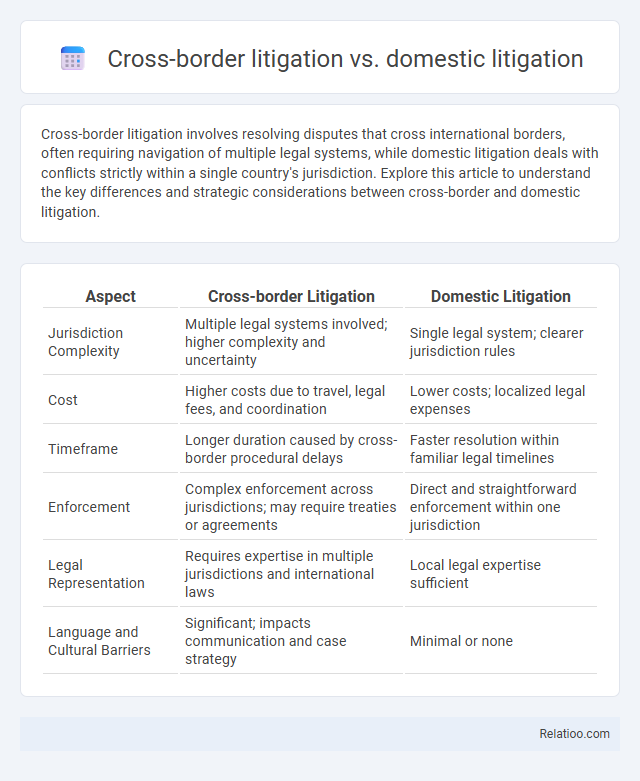Cross-border litigation involves resolving disputes that cross international borders, often requiring navigation of multiple legal systems, while domestic litigation deals with conflicts strictly within a single country's jurisdiction. Explore this article to understand the key differences and strategic considerations between cross-border and domestic litigation.
Table of Comparison
| Aspect | Cross-border Litigation | Domestic Litigation |
|---|---|---|
| Jurisdiction Complexity | Multiple legal systems involved; higher complexity and uncertainty | Single legal system; clearer jurisdiction rules |
| Cost | Higher costs due to travel, legal fees, and coordination | Lower costs; localized legal expenses |
| Timeframe | Longer duration caused by cross-border procedural delays | Faster resolution within familiar legal timelines |
| Enforcement | Complex enforcement across jurisdictions; may require treaties or agreements | Direct and straightforward enforcement within one jurisdiction |
| Legal Representation | Requires expertise in multiple jurisdictions and international laws | Local legal expertise sufficient |
| Language and Cultural Barriers | Significant; impacts communication and case strategy | Minimal or none |
Introduction to Cross-border vs Domestic Litigation
Cross-border litigation involves legal disputes where parties are located in different countries, requiring navigation of multiple legal systems, international treaties, and jurisdictional complexities. Domestic litigation occurs within a single country, governed by that nation's laws, courts, and procedural rules, offering greater predictability and streamlined processes. Understanding these differences is essential for effectively managing dispute resolution strategies in international versus local contexts.
Key Differences Between Cross-border and Domestic Litigation
Cross-border litigation involves legal disputes spanning multiple jurisdictions, requiring navigation of different legal systems, international laws, and enforcement complexities, unlike domestic litigation that occurs within a single country's legal framework. Key differences include jurisdictional challenges, choice of law rules, and service of process complications unique to cross-border cases, whereas domestic litigation benefits from uniform procedural rules and enforcement mechanisms. Cross-border disputes often demand specialized legal strategies to address multinational contractual issues and enforce judgments across borders, contrasting with the more straightforward enforcement in domestic disputes.
Jurisdictional Challenges in Cross-border Litigation
Cross-border litigation poses significant jurisdictional challenges that differ from domestic litigation due to varying legal systems, enforcement mechanisms, and conflicting laws between countries. Your strategy must navigate complex issues such as determining the proper jurisdiction, service of process, and recognition of foreign judgments. Unlike domestic disputes resolved within a single legal framework, cross-border cases require careful analysis of international treaties and local laws to ensure effective dispute resolution.
Choice of Law: Domestic vs International Perspectives
Choice of law in cross-border litigation involves complex evaluation of international treaties, conflict-of-law rules, and jurisdictional principles that differ significantly from domestic litigation, where national legal frameworks and precedents primarily govern dispute resolution. Domestic litigation typically prioritizes local statutes and judicial interpretations, ensuring predictability within a single legal system, whereas cross-border disputes require harmonizing diverse legal norms and considering public policy exceptions to determine applicable law. Effective dispute resolution in an international context demands strategic analysis of forum selection clauses, recognition and enforcement of foreign judgments, and adherence to international arbitration conventions to navigate the multiplicity of legal regimes.
Enforceability of Judgments Across Borders
Enforceability of judgments across borders is a critical factor distinguishing cross-border litigation from domestic litigation, as international judgments require recognition under various treaties such as the Hague Convention or bilateral agreements to be executable. Domestic litigation benefits from unified legal systems and jurisdictional clarity, ensuring straightforward enforcement of judgments within the same country. Disputes involving parties from different jurisdictions often face challenges like conflicting legal standards and the necessity of navigating foreign courts, making enforceability a complex issue demanding specialized legal expertise.
Procedural Complexities Unique to Cross-border Cases
Cross-border litigation involves navigating multiple legal systems, languages, and jurisdictions, creating procedural complexities absent in domestic litigation or standard disputes. Your ability to manage conflicting laws, enforce judgments internationally, and address issues like choice of law and forum selection is critical. These challenges demand specialized expertise to ensure efficient resolution and mitigate delays unique to cross-border cases.
Costs and Duration: Comparative Analysis
Cross-border litigation typically involves higher costs and longer durations than domestic litigation due to complexities such as differing legal systems, jurisdictional challenges, and the need for international legal expertise. Domestic litigation is generally more streamlined and cost-effective, benefiting from familiar procedural rules and local legal infrastructure. Understanding these differences helps you allocate resources efficiently when facing a dispute, balancing time sensitivity against budget constraints.
Role of International Treaties and Conventions
International treaties and conventions play a crucial role in cross-border litigation by providing a harmonized legal framework that facilitates jurisdiction, enforcement of judgments, and dispute resolution between countries. Domestic litigation is primarily governed by a nation's internal laws, lacking the international coordination found in cross-border cases, which often require adherence to multilateral agreements like the Hague Convention or UNCITRAL Model Law. Dispute resolution in international contexts heavily relies on these treaties to ensure predictability, fairness, and mutual recognition of legal processes across jurisdictions.
Common Legal Strategies in Cross-border vs Domestic Disputes
Common legal strategies in cross-border litigation prioritize jurisdictional analysis, choice of law, and international arbitration agreements to address complexities arising from multiple legal systems. In domestic disputes, strategies focus on local court procedures, established case law, and governmental regulations specific to the jurisdiction. Understanding these differences enables you to tailor dispute resolution tactics effectively, ensuring proper compliance and enforcement across borders or within a single legal framework.
Future Trends in Global Dispute Resolution
Cross-border litigation is increasingly shaped by evolving international treaties and technological advancements that streamline evidence sharing and jurisdictional clarity, distinguishing it from domestic litigation which remains governed by national laws and procedural rules. Future trends in global dispute resolution highlight the rise of alternative dispute resolution methods such as arbitration and mediation, often preferred for their efficiency and neutrality in resolving cross-border disputes. Your ability to navigate these complex mechanisms will be crucial as globalization intensifies the interactions between diverse legal systems and fosters innovative approaches in resolving international disputes.

Infographic: Cross-border litigation vs domestic litigation
 relatioo.com
relatioo.com